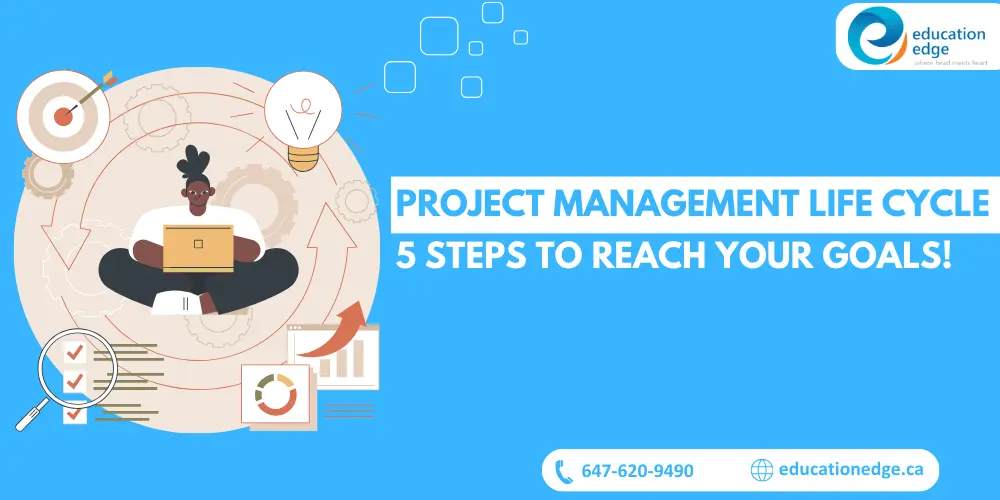
There are many various types of projects, but they all have one element in common. They all undergo the same project management steps, known as the Project Management Life Cycle. Hence, it comprises the 5 stages such as initiating, planning, execution, monitoring and controlling and closing. Whether you are working on a small project with moderate commercial goals or a huge project with ambitious goals, understanding the project management life cycle is important.
No matter what technique or framework you are using, the project management life cycle is a helpful way to think about projects. So, read this blog to know more about each step!
You may also check: Top 7 Project Management Methodologies to Speed Up Your Workflow!
Project Management Life Cycle
The Project Management Life Cycle is a sequential set of techniques for guiding a project from start to finish. It provides project managers with an organized method for planning, executing, and completing a project.
Therefore, this project management procedure is divided into four stages: initiating, planning, executing, and closing. Hence, between the executing and closing stages, some may include a fifth “monitoring and controlling” phase.
What Are the 5 phases of Project Management Life Cycle?
The project management life cycle is broadly divided into 5 phases, which include:
1. Project Initiation
2. Project Planning
3. Project Execution
4. Project Monitoring & Controlling
5. Project Closing
Project Initiation:
In the project initiation stage a business case, feasibility study, cost-benefit analysis, and other types of research are frequently conducted to assess whether the project is feasible and should or should not be performed.
The following are some of the key steps of initiation:
- Interacting with stakeholders to ensure that they are aware of the project’s goals and intended results
- Defining the project’s scope
- SMART goals (specific, measurable, achievable, relevant, and time-bound) are to be established
- Defining resources, such as spending limits and deadlines
- Number of teammates and roles to be determined
- Deciding who the project’s stakeholders will be and how frequently they will participate
- Assembling a project charter and proposal
Project Planning:
Planning involves identifying all of the work that needs to be done and creating the project’s plan. Hence, you should now decide how you will carry out the project and respond to the following questions:
- What actions will we take specifically?
- How will we carry it out?
- When will we execute it?
- When will we know that the task is finished?
The following are the key steps of project planning:
- Choosing the checkpoints that will lead to goal completion
- Establishing a timetable for tasks, including estimated deadlines and potential time delays
- Setting up change processes
- Choosing how and when to interact with the team’s stakeholders
Project Execution:
This is the stage of the project life cycle when you finally get to put your project plan into action. In general, this involves tracking and assessing progress, maintaining quality, reducing risk, maintaining the budget, and utilizing data to guide your decisions.
The following are the key steps of project execution:
- Assign specific project responsibilities to the relevant team members
- Team members are given instructions on how to execute duties, and if necessary, process-related training should be organized
- Update all project stakeholders with new information
- Verify that team members are completing duties on schedule and to a high standard
- Keep an eye on spending and maintain the project’s assets and resources
Project Monitoring & Controlling:
The project monitoring and controlling phase comprises establishing controls and key performance measures to assess the effectiveness of project execution. Hence, The monitoring and controlling project phase is critical to ensuring that the execution goes as planned in terms of time, scope, and budget baselines.
The following are the key steps of project monitoring and controlling:
- Examine timesheets and expenses for tracking, control, and analyze expenses in relation to the project’s budget, timetable, and tasks
- Examining project deliverables to ensure they satisfy the accepted requirements
- Potential risks and issues should be monitored, controlled, managed, and mitigated
- Conduct user acceptability testing and develop a reviewing procedure to ensure that all deliverables match the client’s requirements
- When a project does not proceed as planned, manage the process of approved alterations with the customer to ensure they are satisfied with required changes
Project Closing:
The closing phase of a project’s life cycle is its last stage. It involves more than just finishing the project and closing it down. The client, stakeholders, and project sponsor must all officially sign off on the project and give their approval.
The following are the key steps of project closing:
- Presenting an impact report and informing stakeholders of the project’s conclusion
- Contacting a project’s new owners
- Preparing a project closing report
- Recognizing the achievement and the project’s completion
Make sure to check: How to Get a Project Management Professional Certification?
Frequently Asked Questions
1. What five phases of the project life cycle?
ANS: The five phases of the project life cycle are:
1. Initiating
2. Planning
3. Executing
4. Monitoring/controlling
5. Closing
2. What is the primary purpose of project life cycle management?
ANS: The fundamental purpose is to make sure that projects are planned, implemented, and monitored in an organized way for the best outcome.
3. Can project management life cycles be modified to specific projects?
ANS: Yes, project management life cycles may be modified to match the specific needs of each project.
4. How can a project management life cycle help organizations?
ANS: It improves communication, reduces risks, and boosts project success rates.




